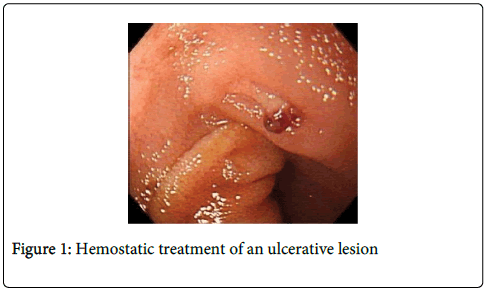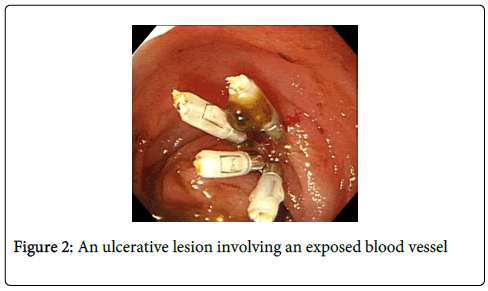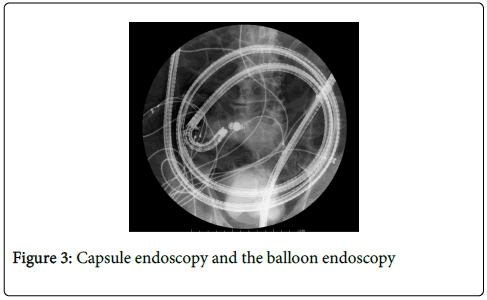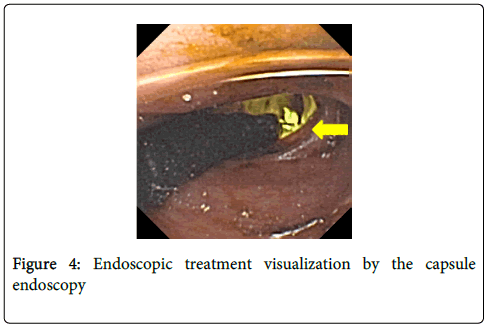Commentary Open Access
Images of Small Bowel Endoscopic Hemostasis Captured by Capsule Endoscopy
Kazuhiro Mizukami* and Kazunari Murakami
Department of Gastroenterology, Oita University, Yufu, Oita, Japan.
- Corresponding Author:
- Kazuhiro Mizukami
Department of Gastroenterology
Faculty of Medicine, Oita University
1-1 Idaigaoka, Hasama, Yufu, Oita 879-5593, Japan
Tel: +81-97-586-6193
Fax: + 81-97-586-6194
E-mail: mizkaz0809@oita-u.ac.jp
Received Date: May 26, 2014; Accepted Date: July 26, 2014; Published Date: August 02, 2014
Citation: Mizukami, Murakami (2014) Images of Small Bowel Endoscopic Hemostasis Captured by Capsule Endoscopy. J Gastroint Dig Syst 4:200. doi:10.4172/2161-069X.1000200
Copyright: © 2014 Mizukami K, et al. This is an open-access article distributed under the terms of the Creative Commons Attribution License, which permits unrestricted use, distribution, and reproduction in any medium, provided the original author and source are credited.
Visit for more related articles at Journal of Gastrointestinal & Digestive System
Keywords
Capsule endoscopy; Double ballon endoscopy; Small bowel hemorrhage; Endoscopic hemostasis; Image
Commentary
An 84-year-old male who had been habitually taking nonsteroidal anti-inflammatory drugs for low back pain was taken to the hospital due to loss of consciousness together with massive bloody bowel discharge. Emergency gastrointestinal endoscopy and colonoscopy revealed bleeding from the distal ileum. He was then referred to our hospital since small bowel hemorrhage was suspected. Capsule endoscopy was performed after abdominal contrast-enhanced computed tomography did not clearly reveal the origin of the hemorrhage. Six hours after ingestion of the capsule endoscopy, a real-time viewer was used to confirm that there was no hemorrhage in the upper half of the small bowel. Double balloon endoscopy with a transanal approach revealed the presence of blood in the entire large bowel and numerous small ulcers in the distal ileum. Hemostatic treatment of an ulcerative lesion involving an exposed blood vessel located 100 cm proximal to the ileocecal valve was performed (Figures 1 and 2). Since the capsule endoscopy and the balloon endoscopy met exactly at the lesion area (Figure 3), the endoscopic treatment was visualized by the capsule endoscopy (Figures 4).
Capsule endoscopy and small bowel endoscopy have greatly improved the diagnosis of the small bowel region. These diagnostic yields are more effective than other modalities, and these are central to the present algorithmic approach of small bowel hemorrhage [1], while tests for overt-ongoing bleeding are considered to be a significant factor in identifying the origin of the hemorrhage [2]. Regarding our cases, we performed capsule endoscopy and double balloon endoscopy on the same day for the early identification of the origin of the hemorrhage. In this case, the capsule endoscopy approaching from the upper gastrointestinal tract and the balloon endoscopy approaching from the lower gastrointestinal tract coincidentally met at the lesion area, which resulted in very rare images that we would like to report.
References
- Pohl J, Delvaux M, Ell C, Gay G, May A, et al. (2008) European Society of Gastrointestinal Endoscopy (ESGE) Guidelines: flexible enteroscopy for diagnosis and treatment of small-bowel diseases. Endoscopy 40: 609-618.
- Tanaka S, Mitsui K, Yamada Y, Ehara A, Kobayashi T, et al. (2008) Diagnostic yield of double-balloon endoscopy in patients with obscure GI bleeding. GastrointestEndosc 68: 683-691.
Relevant Topics
- Constipation
- Digestive Enzymes
- Endoscopy
- Epigastric Pain
- Gall Bladder
- Gastric Cancer
- Gastrointestinal Bleeding
- Gastrointestinal Hormones
- Gastrointestinal Infections
- Gastrointestinal Inflammation
- Gastrointestinal Pathology
- Gastrointestinal Pharmacology
- Gastrointestinal Radiology
- Gastrointestinal Surgery
- Gastrointestinal Tuberculosis
- GIST Sarcoma
- Intestinal Blockage
- Pancreas
- Salivary Glands
- Stomach Bloating
- Stomach Cramps
- Stomach Disorders
- Stomach Ulcer
Recommended Journals
Article Tools
Article Usage
- Total views: 14280
- [From(publication date):
August-2014 - Apr 05, 2025] - Breakdown by view type
- HTML page views : 9754
- PDF downloads : 4526




